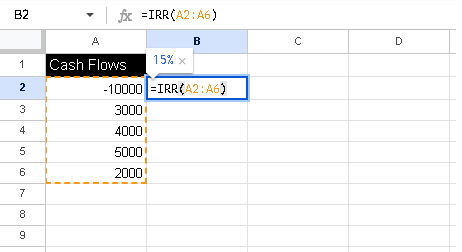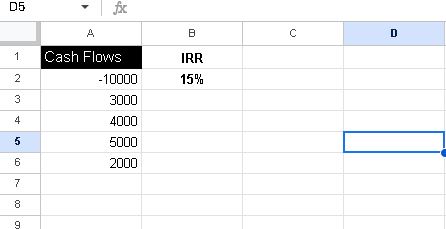What is the internal rate of return?
The internal rate of return (IRR) is a capital budgeting method used to evaluate the profitability of an investment or project. It represents the rate at which the net present value (NPV) of cash flows from the investment equals zero.
In other words, it is the discount rate that makes the present value of the investment’s cash inflows equal to the present value of its cash outflows. The IRR is expressed as a percentage and provides insights into the potential return an investment can generate.
To calculate the IRR, cash inflows and outflows from the investment are estimated over a specified period. These cash flows are discounted back to their present value using the IRR as the discount rate. The IRR is then adjusted iteratively until the NPV of the investment equals zero.
If the resulting IRR is higher than the required rate of return or the cost of capital, the investment is considered attractive as it generates a positive return. Conversely, if the IRR is lower than the required rate of return, the investment may be deemed less favorable.
The IRR is a crucial tool in financial decision-making as it helps investors compare different investment opportunities and assess their potential profitability. It allows for an understanding of the inherent risk associated with an investment, as a higher IRR typically implies a higher risk.
The IRR can be used to determine the viability of projects, make capital budgeting decisions, or evaluate the potential returns of a business venture. However, it is important to consider other factors, such as the investment’s cash flow patterns, timing, and risk profile, alongside the IRR to make well-informed investment decisions.
Understanding the concept
The internal rate of return (IRR) is a financial metric used to assess the profitability of an investment. It represents the discount rate at which the net present value (NPV) of cash flows from the investment becomes zero. In simpler terms, the IRR tells us the annualized rate of return that an investment is expected to generate.
If the IRR exceeds the required rate of return, the investment is considered attractive. On the other hand, if the IRR is lower than the required rate of return, the investment may be less favorable. The IRR helps investors evaluate different investment opportunities and make informed decisions based on their potential returns and associated risks.
How to calculate the internal rate of return
To calculate the internal rate of return (IRR), you can use either a financial calculator or spreadsheet software. Here’s a step-by-step example of how to calculate IRR:
- Identify the cash flows: Determine the cash inflows and outflows associated with the investment or project over a specific period.
- Organize the cash flows: List the cash flows in chronological order, with the initial investment as a negative value (outflow) and subsequent cash inflows as positive values.
- Set up the equation: Set up the equation where the sum of the present values of the cash flows equals zero. The present value of each cash flow is calculated by dividing it by (1+IRR)^n, where n represents the period number.
- Iterate to find the IRR: Use trial and error or built-in functions in software to find the discount rate (IRR) that makes the equation balance. You can change the discount rate until the sum of the present values of the cash flows is closest to zero.
Internal rate of return used for
The internal rate of return (IRR) is used for several purposes in financial analysis and decision-making. Here is a brief overview of its key applications:
Investment Appraisal:
IRR helps in evaluating the potential profitability of an investment. By comparing the IRR with the required rate of return or the cost of capital, investors can determine whether an investment is attractive or not. If the IRR is higher than the required rate of return, the investment may be considered favorable.
Capital Budgeting:
IRR plays a crucial role in capital budgeting decisions, where organizations assess and prioritize investment projects. By calculating the IRR of each project, they can compare and select the projects that offer the highest potential returns.
Business Valuation:
IRR is often used in business valuation to estimate the worth of a company or a specific investment. It helps investors gauge the expected rate of return and assess the value of the future cash flows generated by the business.
Project Selection:
IRR assists in selecting among competing projects or ventures. Comparing the IRRs of different projects allows decision-makers to choose the ones with the highest potential returns, given the associated risks.
Performance Evaluation:
IRR can be used as a performance metric for existing investments or projects. By comparing the actual IRR achieved with the expected or target IRR, investors can assess the performance and profitability of their investments.
Importance of internal rate of return
The internal rate of return (IRR) holds significant importance in financial analysis and decision-making. Here’s a brief outline of its key significance:
Investment Evaluation:
The IRR helps assess the profitability of an investment by providing a clear measure of the potential rate of return. It allows investors to compare different investment opportunities and determine which ones are most attractive based on their IRRs.
Decision-Making Tool:
The IRR serves as a valuable tool in decision-making processes such as capital budgeting and project selection. By considering the IRR alongside other factors like risk and cash flow patterns, decision-makers can make informed choices about resource allocation and investment priorities.
The gauge of Viability:
The IRR helps determine the viability of an investment or project by comparing it to the required rate of return or the cost of capital. If the IRR exceeds the required rate, it indicates that the investment is potentially profitable.
Performance Assessment:
The IRR is useful for evaluating the performance of existing investments or projects. By comparing the achieved IRR with the expected or target IRR, stakeholders can gauge the success and profitability of their investments.
Risk-Return Tradeoff:
The IRR provides insights into the risk-return tradeoff associated with an investment. Higher IRRs typically correspond to higher risks, allowing investors to assess the potential returns about the inherent risks involved.
Business Valuation:
The IRR plays a role in estimating the value of a business or investment opportunity. It helps investors determine the worth of future cash flows by considering the expected rate of return.
How to make the decision based on IRR
Making decisions based on the internal rate of return (IRR) involves comparing the calculated IRR of an investment or project with the required rate of return or the cost of capital. Here’s a brief overview of the decision-making process based on IRR:
- Compare IRR with Required Rate of Return: If the IRR is higher than the required rate of return, it suggests that the investment is potentially profitable. In such cases, it is generally considered a favorable decision to proceed with the investment.
- Assess Risk and Other Factors: While the IRR provides valuable insights into potential returns, it is essential to consider other factors alongside the IRR. These factors may include the project’s cash flow patterns, the duration of the investment, market conditions, and associated risks. A comprehensive evaluation should be conducted to ensure a well-informed decision.
- Consider Alternative Investments: If there are multiple investment options, compare the IRRs of each opportunity. Select the investment with the highest IRR, as it indicates the potential for a greater return on investment. However, consider other factors such as risk, liquidity, and alignment with strategic objectives before finalizing the decision.
- Evaluate Sensitivity Analysis: Perform sensitivity analysis to determine how changes in key variables impact the IRR. By assessing the sensitivity of the IRR to factors like sales volume, costs, or interest rates, decision-makers can gain a better understanding of the investment’s risk profile and potential outcomes under different scenarios.
- Consider Capital Constraints: It is crucial to assess the availability of capital or funding for the investment. If there are limited resources, prioritize investments with higher IRRs and favorable risk-return profiles.
Practical example of the internal rate of return
let’s consider an investment with an initial outflow of $10,000 and subsequent cash inflows of $3,000, $4,000, $5,000, and $2,000 in consecutive years. By calculating the IRR, we can determine the annualized rate of return.
- Year 0: -$10,000 (initial investment)
- Year 1: $3,000
- Year 2: $4,000
- Year 3: $5,000
- Year 4: $2,000
Using a financial calculator or spreadsheet software, you would input these cash flows and find that the IRR is approximately 15.3%. This means that the investment is expected to generate an annualized return of around 15.3%.
Remember, the IRR is just one metric to evaluate an investment, and it should be used in conjunction with other factors to make well-informed decisions.
How to calculate IRR in MS Excel
- Year 0: -$10,000 (initial investment)
- Year 1: $3,000
- Year 2: $4,000
- Year 3: $5,000
- Year 4: $2,000

In column A, list the cash flows associated with the investment or project. The initial investment should be entered as a negative value, while subsequent cash inflows should be positive values. For this example, we’ll assume the following cash flows:
- In cell A1, enter the label “Cash Flows”. Then, in cells A2 to A6, input the corresponding cash flow amounts.
- In cell B1, enter the label “IRR”.
- In cell B2, input the following formula to calculate the IRR:
- =IRR(A2:A6)
- Press Enter, and Excel will calculate the IRR based on the provided cash flows.
By following these steps and inputting the appropriate formulas in Excel, you can easily calculate the IRR for your investment or project as per below.


Limitations of internal rate of return
The internal rate of return (IRR) has several limitations that should be taken into account when using this financial metric. Here’s a short overview of its limitations:
Multiple IRRs:
In some cases, investments with unconventional cash flow patterns or multiple changes in cash flow direction may result in multiple IRRs. This ambiguity makes it difficult to interpret the IRR accurately.
Reinvestment Assumption:
The IRR assumes that all cash flows generated from the investment are reinvested at the calculated IRR. However, in practice, it may not be feasible or realistic to reinvest at the exact IRR, leading to potential discrepancies between expected and actual returns.
Cash Flow Timing:
The IRR does not consider the timing of cash flows, except for the initial investment and the final cash flow. It assumes that all cash flows occur at the end of each period, which may not reflect the actual timing of cash flows in real-world scenarios.
Size Bias:
The IRR does not consider the scale or magnitude of the investment. Therefore, it may favor smaller projects with higher IRRs over larger projects with lower IRRs, even if the latter may generate more substantial returns in absolute terms.
Lack of External Factors:
The IRR does not account for external factors such as inflation rates, market conditions, or economic changes. Ignoring these factors may result in an inaccurate assessment of the investment’s actual risk and return potential.
Difficulty in Comparison:
Comparing the IRR of different investments may not provide a clear indication of their relative profitability, especially if the investments have different risk profiles or cash flow patterns. Additional metrics and analysis are required to make comprehensive investment comparisons.





[…] Internal Rate of Return (IRR) is a capital budgeting metric used to assess the profitability of an investment project. It […]